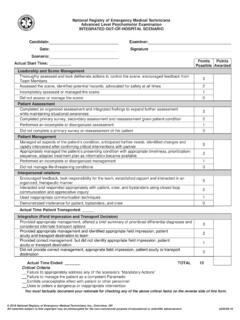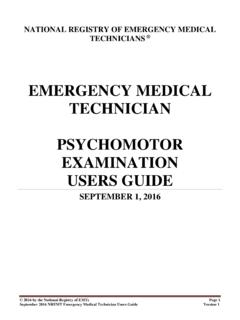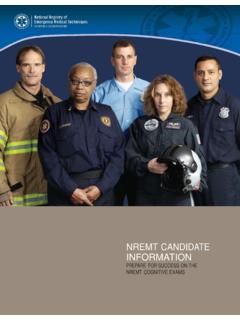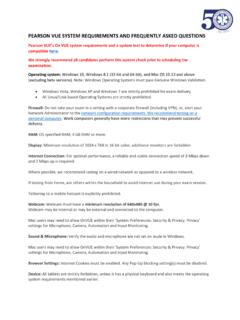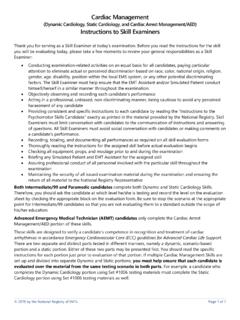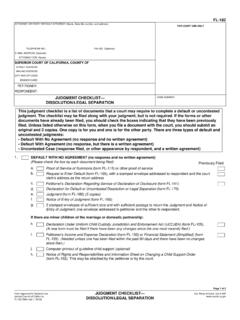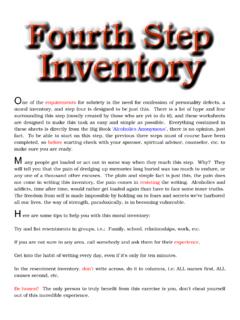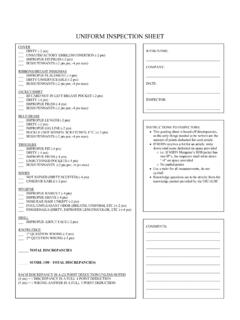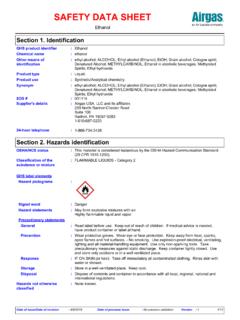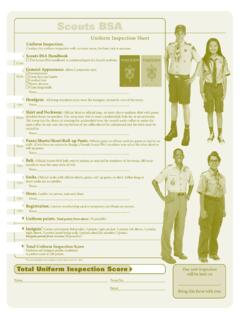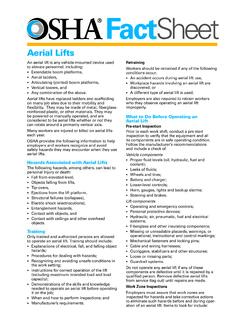Transcription of National Registry of Emergency Medical Technicians ...
1 National Registry of Emergency Medical Technicians Emergency Medical Technician Psychomotor Examination PATIENT ASSESSMENT/MANAGEMENT TRAUMA. Candidate: Examiner: Date: Signature: Scenario #. Possible Points Actual Time Started: _____ Note: Areas denoted by ** may be integrated within sequence of Primary Survey/Resuscitation Points Awarded Takes or verbalizes appropriate PPE precautions 1. SCENE SIZE-UP. Determines the scene/situation is safe 1. Determines the mechanism of injury/nature of illness 1. Determines the number of patients 1. Requests additional EMS assistance if necessary 1. Considers stabilization of the spine 1. PRIMARY SURVEY/RESUSCITATION.
2 Verbalizes general impression of the patient 1. Determines responsiveness/level of consciousness 1. Determines chief complaint/apparent life-threats 1. Airway 2. -Opens and assesses airway (1 point) -Inserts adjunct as indicated (1 point). Breathing -Assess breathing (1 point) -Assures adequate ventilation (1 point) 4. -Initiates appropriate oxygen therapy (1 point) -Manages any injury which may compromise breathing/ventilation (1 point). Circulation -Checks pulse (1point). -Assess skin [either skin color, temperature or condition] (1 point) 4. -Assesses for and controls major bleeding if present (1 point). -Initiates shock management [positions patient properly, conserves body heat] (1 point).
3 Identifies patient priority and makes treatment/transport decision (based upon calculated GCS) 1. HISTORY TAKING. Obtains baseline vital signs [must include BP, P and R] (1 point) 1. Attempts to obtain SAMPLE history 1. SECONDARY ASSESSMENT. Head -Inspects and palpates scalp and ears (1 point) ** -Assesses eyes (1 point) 3. - (1 point)mouth**, nose** and assesses facial area (1 point). -Inspects Neck**. -Checks position of trachea (1 point) -Checks jugular veins (1 point) -Palpates cervical spine (1 point) 3. Chest**. -Inspects chest (1 point) -Palpates chest (1 point) -Auscultates chest (1 point) 3. Abdomen/pelvis**. -Inspects and palpates abdomen (1 point) -Assesses pelvis (1 point) 3.
4 -Verbalizes assessment of genitalia/perineum as needed (1 point). Lower extremities**. -Inspects, palpates and assesses motor, sensory and distal circulatory functions (1 point/leg) 2. Upper extremities -Inspects, palpates and assesses motor, sensory and distal circulatory functions (1 point/arm) 2. Posterior thorax, lumbar and buttocks**. -Inspects and palpates posterior thorax (1 point) -Inspects and palpates lumbar and buttocks areas (1 point) 2. Manages secondary injuries and wounds appropriately 1. REASSESSMENT. Demonstrates how and when to reassess the patient 1. Actual Time Ended: _____ TOTAL 42. CRITICAL CRITERIA. ____ Failure to initiate or call for transport of the patient within 10 minute time limit ____ Failure to take or verbalize appropriate PPE precautions ____ Failure to determine scene safety ____ Failure to assess for and provide spinal protection when indicated ____ Failure to voice and ultimately provide high concentration oxygen ____ Failure to assess/provide adequate ventilation ____ Failure to find or appropriately manage problems associated with airway, breathing.
5 Hemorrhage or shock ____ Failure to differentiate patient's need for immediate transportation versus continued assessment/treatment at the scene ____ Performs other assessment before assessing/treating threats to airway, breathing and circulation ____ Failure to manage the patient as a competent EMT. ____ Exhibits unacceptable affect with patient or other personnel ____ Uses or orders a dangerous or inappropriate intervention You must factually document your rationale for checking any of the above critical items on the reverse side of this form. 2016 by the National Registry of Emergency Medical Technicians , Inc., Columbus, OH. All materials subject to this copyright may be photocopied for the non-commercial purpose of educational or scientific advancement.
6 E201/10-16.
